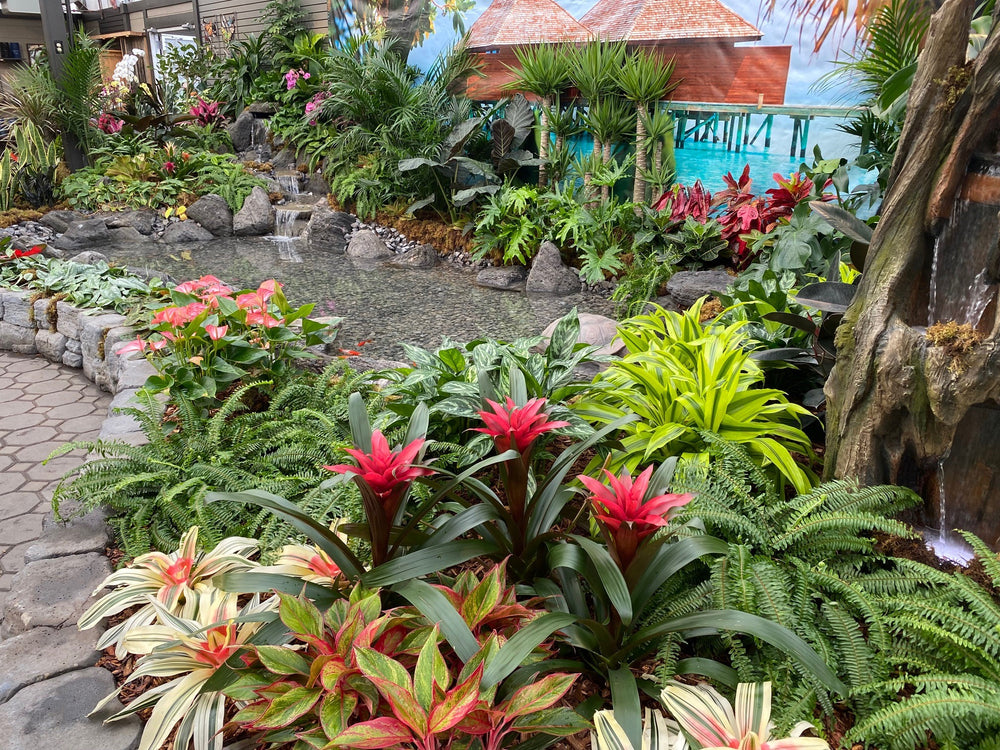Spotlight on Aroids
As featured on 630 CHED Garden Show - September 18, 2022
Aroids are plants that belong to the Arum Family (Araceae). This group includes many popular garden plants, houseplants, and wildflowers. Some famous and well-known examples include the corpse flower (Amorphophallus titanum), Jack-in-the-pulpit (Arisaema triphyllum), elephant ears (Colocasia and Alocasia spp. – not to be confused with Bergenia), peace lily (Spathiphyllum spp.), calla lily (Zantedeschia spp.), pothos (Epipremnum and Scindapsus spp.), and Monstera. These vary so much in plant size, leaf shape, and leaf colour, but they all have the same floral anatomy: a central “spike” of tiny flowers called the spadix, surrounded by a sheath called the spathe, which in some species is large, showy, and hooded, while in others is quite nondescript. So, depending on the species, some aroids are grown for their flowers, while others are grown for their foliage; most houseplants belonging to this group are foliage plants.
Regarding toxicity, all aroids produce chemical compounds called calcium oxalate, which in small doses will just cause a burning sensation in the mouth. These plants are not a big danger to have in the home but should be kept out of reach of any children or pets that like to chew on plants.
We recently received a shipment of rare and noteworthy tropical aroids, and thought we'd highlight some!
Alocasia 'Jacklyn'

- Rare variety with deeply lobed yellow leaves that have a rough texture and contrasting deep green veining.
- Alocasia are tuberous plants that like warmth and consistent moisture (but also excellent soil drainage). If they are kept too cool or dry over winter, they may drop their leaves and go dormant. Keep dry until warmth and light return in late winter/early spring.
- Bright, indirect light.
Anthurium hookeri 'Variegatum'

- This species is very vigorous and easy to grow, and often overlooked; called “birdsnest anthurium” because of the arrangement of the long, narrow leaves.
- A rare, variegated form that adds extra interest with splashes of white on the leaves.
- Bright, indirect light; allow the top third to half of soil to dry between watering.
Cercestis mirabilis

- A new introduction to the market, with gorgeous arrowhead shaped, white leaves with green veining.
- This is a climber that can be expected to have a similar habit and requirements to Syngonium but will develop larger leaves.
- Try growing it on a pole for dramatic effect.
Homalomena humilis 'Black Form'

- Another new introduction that has exquisite, narrow, rippled, velvety burgundy-black leaves.
- Needs bright, indirect light and consistent moisture coupled with good drainage.
- Homalomena can get brown leaf margins in low humidity.
Homalomena wallisii 'Camouflage'

- This is very similar to ‘Selby’ but with yellow-green mottling instead of silver-green.
- The leaves have a thicker substance and are oval shaped.
- Requirements are the same as for other Homalomena.
Philodendron 'Jose Bueno'

- Sought after hybrid that develops large leaves with creamy-white speckles and blotches; a real showpiece when mature.
- Will start to climb as it matures.
- Easily grown under standard Philodendron conditions: bright, indirect light; water when 30% dry.
Philodendron 'Ring of Fire'

- Popular hybrid with long, narrow leaves that have soft sawtooth margins.
- The leaves emerge red and mature green with creamy-white speckles and blotches; beautiful.
- Also easy to grow, but prone to fungal spotting if watered overhead.
Philodendron billietiae

- This species is not commonly offered and develops large, arrowhead shaped, glossy green leaves.
- Has a climbing habit.
- Not difficult to grow but does appreciate higher humidity.
Philodendron brandtianum

- Climber with heart shaped, silver leaves with green veining.
- Can be grown as a “shingle plant” – stems will attach themselves to a flat board and the leaves will grow flat against it.
- Relatively easy to grow but also appreciates higher humidity.
Philodendron melanochrysum

- Very dramatic climber with large leaves, which looks great on a pole.
- The name melanochrysum means “black gold” – the velvety leaves are a dark colour with silvery veins and a sparkly sheen; the undersides are reddish.
- Resembles Philodendron micans but with much larger leaves.
Philodendron verrucosum

- Spectacular climber with large, heart shaped leaves that have an almost iridescent quality.
- Medium green with lime-green veins, and the reddish undersides show through the top.
- Again has a preference for higher humidity.
Schismatoglottis 'Silver Form'

- New introduction with broad, silver leaves with grey-green margins and veins.
- Schismatoglottis are slightly finicky plants that need a perfect balance of moisture and drainage, plus high humidity.
Schismatoglottis hendrikii

- Similar to ‘Silver Form’ but with broader, metallic silver leaves that tend to have a deep green stripe down the centre.
Syngonium wendlandii

- This is a climber/trailer that was previously quite rare, but now becoming more readily available.
- Arrowhead shaped leaves are deep green, with white centres.
- Easily grown as with other Syngonium: bright, indirect light; water when 30% dry.


